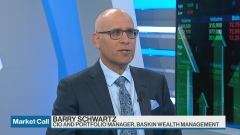1h ago
Lilly’s Mounjaro Gives Positive Results in Obese Diabetic People
, Bloomberg News
(Bloomberg) -- Eli Lilly & Co.’s diabetes drug Mounjaro significantly lowered blood sugar in people with the disease who were also obese, according to details from a study that raises the treatment’s profile in comparison to rivals.
About half of participants in the late-stage study saw their blood sugar fall into normal range, with an overall drop of 2.1 percentage points, according to findings from a Lilly study released late Friday at the American Diabetes Association conference in San Diego. In a separate, similar study, patients who received semaglutide, the active component in several Novo Nordisk A/S diabetes and weight-loss drugs, saw blood sugar drop by 1.6 percentage points.
Mounjaro “is probably the best medicine other than insulin to treat diabetes, and this shows that it’s the best medicine to treat obesity in diabetes,” Tim Garvey, director of the University of Alabama’s Diabetes Research Center and lead author of the study, said in an interview.
The details flesh out the main findings of Lilly’s final-stage study released in April that the company plans using to apply for Mounjaro’s US clearance to treat obesity. The full study adds another layer of effectiveness to a product that has already become a runaway success and propelled Lilly to its status as the world’s most valuable drugmaker.
Read More: Diabetes To Afflict 1.3 Billion Globally by 2050, Study Finds
Diabetes occurs when the body loses the ability to control blood sugar, and it’s one of the world’s most common serious diseases. The number of people globally with the condition will more than double to about 1.3 billion by 2050, according to an estimate published Thursday in the Lancet medical journal, mainly fueled by aging and increased obesity in the population.
Type 2, the most common form of diabetes, is frequently linked to obesity. Mounjaro is a weekly injection that, initially developed as a diabetes medication, makes people feel full. Many people have already begun using the drug as a weight-loss aid.
Hemoglobin A1C, a widely used measure of blood sugar levels over time, fell to an average of 5.9% from 8% among people who received Lilly’s drug. The post-treatment level is close to the normal range — below 5.7% - that’s associated with a reduced risk of diabetes complications like heart, kidney, nerve and eye disease.
Also, people who got the treatment didn’t suffer cases of severe low blood sugar, which can sometimes occur when diabetes is treated aggressively. Low blood sugar can cause a number of symptoms, including disorientation and sometimes, in severe cases, loss of consciousness.
Garvey called the study a landmark because it showed the drug provided blood sugar control that’s normally very difficult to achieve in diabetes. Mounjaro helped patients who were both diabetic and obese lose as much as 15% of their body weight, or around 30 pounds, according to initial data released in April.
Wall Street has enormous expectations for these new medicines, called GLP-1s, with Jefferies projecting a $150 billion market by 2031. Some analysts see Mounjaro soon becoming the biggest drug in the class, surpassing Novo Nordisk A/S’s Wegovy and Saxenda, two earlier obesity drugs. Novo’s diabetes drug Ozempic is also used off label for weight loss.
Mounjaro was approved by the FDA last May as a treatment for type 2 diabetes. It is expected to become a blockbuster this year, with average projections of $3.5 billion in 2023 sales.
©2023 Bloomberg L.P.



